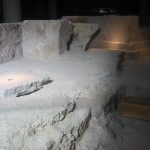Sanliurfa organizes an online event in which Creative Cities so outstanding such as Baku or Bogotá will participate as well
The musical prestige and the patrimonial wealth of Llíria resound increasingly more strongly at an international level. Thanks to its belonging to the UNESCO Creative Cities Network, the four main Edetan music bands have been invited to participate in an innovative online festival organized by Sanliurfa, a historic Turkish city not far from the river Euphrates, which will take place next June 16 and 17.
For this event, the Edetan music groups have gathered up in different formations in order to offer the world part of their repertoire from four patrimonial enclaves. In this way, the “Quintet Vent a Cinc de la Banda Primitiva de Llíria” will perform at the Roman Mausoleums; the “Agrupación Musical Edetana Vicente Giménez” at Ca la Vila; the “Grup Harmoniemusik de la Unió Musical” at the Roman Baths and the “Orquestra de Plectre El Micalet” in La Sang. All these concerts have previously been recorded and voiced with the latest digital technology to show internationally the musical and patrimonial excellence of Llíria City of Music.
The festival, which has the support of the heads of tourism in Turkey, aims to Creative Cities with a rich multicultural heritage unite through music. On this account, Llíria has been chosen along with five other cities of the UNESCO Network: Kirsehir (Turkey), Baku (Azerbaijan), Essaouira (Morocco), Ibagué and Bogotá (Colombia).
The mayor of the Metropolitan Municipality of Sanliurfa, Zeynel Abidin BEY AZGUL, invited by letter to the Edetan mayor Manuel Civera, who accepted the invitation and promised to promote Sanliurfa’s candidacy within the Creative Cities Network: “For Llíria it is an honour to be invited to an international event of such magnitude, in which we can show the whole world what defines us the most: the excellence of our musicians and the wealth of our multicultural heritage. Surely many spectators will be attracted to visit our city and we will welcome them with open arms. We feel very close to Sanliurfa – ancient Edessa – not only because of the name and because of our rich past, but also because of our aspirations for the future within the UNESCO Network. Hopefully, Sanliurfa can be a full member like Llíria very soon. Organizing an international festival of such characteristics in these times proves a strong cultural commitment that makes us give our sincere congratulations to this friend-city of Turkey.”
The festival can be followed online at www.youtube.com/sanliurfabld and begins on Wednesday, June 16 at 1:15 pm. The performances of Llíria are scheduled for Wednesday 16 at 3:45 p.m. (Unió Musical and Vicente Giménez) and Thursday 17 at 15:30 (Banda Primitiva and Plectre El Micalet). From one in the afternoon to eight in the afternoon on Wednesday and Thursday, a varied musical selection can be enjoyed online with excellent images from countries such as Colombia, Azerbaijan, Turkey or Morocco. On Friday 18 representatives of Llíria City of Music will participate in two panels that can also be followed online, on ‘Music and Heritage’ and ‘The music industry in times of COVID-19’.









